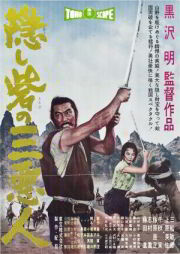 The Hidden Fortress is our film club title for March, and throughout the month we will be discussing this 1958 work by Kurosawa, known as 隠し砦の三悪人 (literally “Three bad men of a hidden fortress”) in its original Japanese.
The Hidden Fortress is our film club title for March, and throughout the month we will be discussing this 1958 work by Kurosawa, known as 隠し砦の三悪人 (literally “Three bad men of a hidden fortress”) in its original Japanese.
After the three thematically fairly heavy films Record of a Living Being, Throne of Blood and The Lower Depths, Kurosawa felt the need to make something lighter and more entertaining. The three films had also been visually fairly confined, and Kurosawa was now interested in the possibility of utilising more screen space. The result was Kurosawa’s first wide screen film and probably his lightest, least intellectually challenging film, The Hidden Fortress.
While Kurosawa’s three previous films had been limited in their number of locations, culminating in the single lodging house of The Lower Depths, The Hidden Fortress was conceived as an action adventure film with movement as its narrative motive. Not since The Men Who Tread on the Tiger’s Tail (1945), and to a lesser extent One Wonderful Sunday (1947), had Kurosawa used travelling and movement as such a central plot device. The former film was influential also in other ways, with The Hidden Fortress reusing its basic story of a group of individuals trying to escape through enemy lines.
However, while Tiger’s Tail is rich in subtext, arguably working as a commentary both on the (then) on-going war as well as Japanese performance arts, similarly complex interpretations of The Hidden Fortress are more difficult to come by. In fact, while generally liked — Richie calls it “near to being the most lovable film Kurosawa has ever made” (135) — The Hidden Fortress is typically considered as one of Kurosawa’s weakest efforts, “primarily a rousing action-comedy” (Desser, 92), or as Yoshimoto puts it somewhat more bluntly, “technically superb yet trite”, “too formulaic and shallow” (272-273).
While indeed rhythmically spot on and excellently cinematographed, it lacks depth in its story and characters, and this isn’t really helped by the performance of its central actors, Misa Uehara as Princess Yuki. While the other characters in the film are largely played by long time acting veterans, Uehara was a total unknown appearing in her first role in a film career that lasted altogether three years. Much of the criticism can and should probably be directed at Kurosawa, whose casting decision fails to provide the necessary depth and roundness to the only character in the story that undergoes any psychological and moral growth.
Despite the film’s shortcomings, Martinez nevertheless considers The Hidden Fortress as “a pivotal film between [Kurosawa’s] earlier work that focused on issues of guilt and the later films that were more interested in the theme of responsibility”. (163) Martinez argues that unlike in Kurosawa’s films of the early 50s, where “characters have to learn (or fail to learn) how to accept responsibility for their actions”, the latter films, starting with The Hidden Fortress, “are more interested in the acceptance of responsibility as the way in which true heroism is made” (163), manifested in The Hidden Fortress primarily in Princess Yuki’s growth story.
Although not generally considered among Kurosawa’s best work, The Hidden Fortress is nevertheless one of his most watched, a fact that is at least partly due to its role as a source for George Lucas’s Star Wars, which will be our film club title for April. The Hidden Fortress was also a big box office success at the time of its release, making back the considerable investment that Toho put into the production. The same fate did not befall the film’s 2008 remake The Last Princess, which failed to excite audiences either in Japan or overseas, but did sort of excite me.
Just like it has not really invited much in-depth discussion from the usual Kurosawa scholars, discussion of The Hidden Fortress has been quite muted also here at akirakurosawa.info. In fact, the only substantial threads that I was able to find are the following three:
– The Princess Problem
– The Star Wars Connection
– Hidden Fortress Question
So, is that all there is to say about The Hidden Fortress, or have we — and those who have come before us — missed something important? And if you do like The Hidden Fortress, as I know many here do, what is it that makes you love it?
As usual, information about the availability of the film can be found from the DVD releases page, while a full schedule of our film club is available from the film club page. As I mentioned before, The Hidden Fortress will be followed by Star Wars (episode 4, that is, the first one that was made), so get your lightsabers ready!






I think that to a certain extent its not a film which stands up to too much discussion – it is what it is – a great, rousing example of film as entertainment. What I do find interesting about it is that it seems to tap into deeper traditional tropes of storytelling, hence its long life as the unacknowledged influence for many later sci fi and fantasy films. I agree very much with Martinez’s arguments that traditional folk tales were a much greater influence on Kurosawa than is often acknowledged.
As to liking or loving it, curiously it was one of the few Kurosawa films I didn’t like on first viewing, although as so often, this may have been the circumstances when I viewed it. But on later views, it has grown on me, although being honest I would never reach for it for another look as I frequently do for Seven Samurai or Yojimbo. But I’ll have another look this month and I’ll see if it changes my mind.